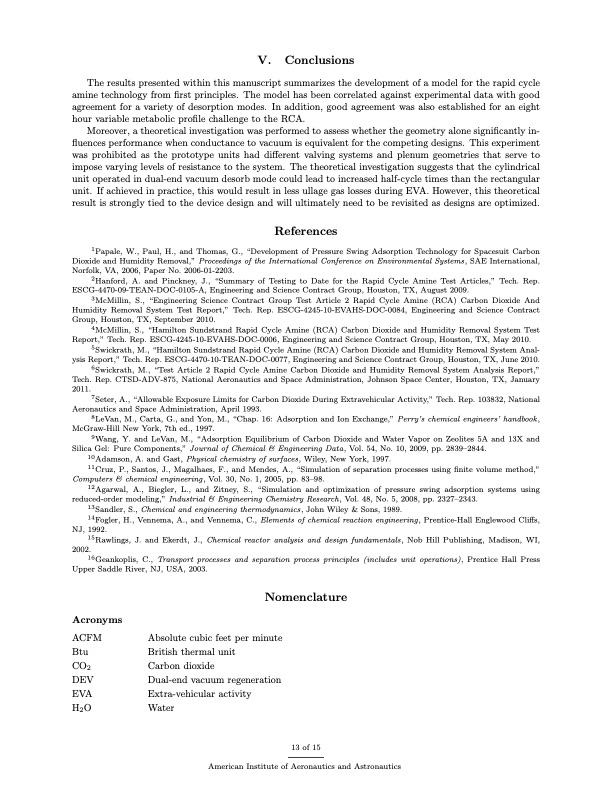
PDF Publication Title:
Text from PDF Page: 013
ACFM Absolute cubic feet per minute Btu British thermal unit CO2 Carbon dioxide DEV Dual-end vacuum regeneration EVA Extra-vehicular activity H2O Water V. Conclusions The results presented within this manuscript summarizes the development of a model for the rapid cycle amine technology from first principles. The model has been correlated against experimental data with good agreement for a variety of desorption modes. In addition, good agreement was also established for an eight hour variable metabolic profile challenge to the RCA. Moreover, a theoretical investigation was performed to assess whether the geometry alone significantly in- fluences performance when conductance to vacuum is equivalent for the competing designs. This experiment was prohibited as the prototype units had different valving systems and plenum geometries that serve to impose varying levels of resistance to the system. The theoretical investigation suggests that the cylindrical unit operated in dual-end vacuum desorb mode could lead to increased half-cycle times than the rectangular unit. If achieved in practice, this would result in less ullage gas losses during EVA. However, this theoretical result is strongly tied to the device design and will ultimately need to be revisited as designs are optimized. References 1Papale, W., Paul, H., and Thomas, G., “Development of Pressure Swing Adsorption Technology for Spacesuit Carbon Dioxide and Humidity Removal,” Proceedings of the International Conference on Environmental Systems, SAE International, Norfolk, VA, 2006, Paper No. 2006-01-2203. 2Hanford, A. and Pinckney, J., “Summary of Testing to Date for the Rapid Cycle Amine Test Articles,” Tech. Rep. ESCG-4470-09-TEAN-DOC-0105-A, Engineering and Science Contract Group, Houston, TX, August 2009. 3McMillin, S., “Engineering Science Contract Group Test Article 2 Rapid Cycle Amine (RCA) Carbon Dioxide And Humidity Removal System Test Report,” Tech. Rep. ESCG-4245-10-EVAHS-DOC-0084, Engineering and Science Contract Group, Houston, TX, September 2010. 4McMillin, S., “Hamilton Sundstrand Rapid Cycle Amine (RCA) Carbon Dioxide and Humidity Removal System Test Report,” Tech. Rep. ESCG-4245-10-EVAHS-DOC-0006, Engineering and Science Contract Group, Houston, TX, May 2010. 5Swickrath, M., “Hamilton Sundstrand Rapid Cycle Amine (RCA) Carbon Dioxide and Humidity Removal System Anal- ysis Report,” Tech. Rep. ESCG-4470-10-TEAN-DOC-0077, Engineering and Science Contract Group, Houston, TX, June 2010. 6Swickrath, M., “Test Article 2 Rapid Cycle Amine Carbon Dioxide and Humidity Removal System Analysis Report,” Tech. Rep. CTSD-ADV-875, National Aeronautics and Space Administration, Johnson Space Center, Houston, TX, January 2011. 7Seter, A., “Allowable Exposure Limits for Carbon Dioxide During Extravehicular Activity,” Tech. Rep. 103832, National Aeronautics and Space Administration, April 1993. 8LeVan, M., Carta, G., and Yon, M., “Chap. 16: Adsorption and Ion Exchange,” Perry’s chemical engineers’ handbook, McGraw-Hill New York, 7th ed., 1997. 9Wang, Y. and LeVan, M., “Adsorption Equilibrium of Carbon Dioxide and Water Vapor on Zeolites 5A and 13X and Silica Gel: Pure Components,” Journal of Chemical & Engineering Data, Vol. 54, No. 10, 2009, pp. 2839–2844. 10Adamson, A. and Gast, Physical chemistry of surfaces, Wiley, New York, 1997. 11Cruz, P., Santos, J., Magalhaes, F., and Mendes, A., “Simulation of separation processes using finite volume method,” Computers & chemical engineering, Vol. 30, No. 1, 2005, pp. 83–98. 12Agarwal, A., Biegler, L., and Zitney, S., “Simulation and optimization of pressure swing adsorption systems using reduced-order modeling,” Industrial & Engineering Chemistry Research, Vol. 48, No. 5, 2008, pp. 2327–2343. 13Sandler, S., Chemical and engineering thermodynamics, John Wiley & Sons, 1989. 14Fogler, H., Vennema, A., and Vennema, C., Elements of chemical reaction engineering, Prentice-Hall Englewood Cliffs, NJ, 1992. 15Rawlings, J. and Ekerdt, J., Chemical reactor analysis and design fundamentals, Nob Hill Publishing, Madison, WI, 2002. 16Geankoplis, C., Transport processes and separation process principles (includes unit operations), Prentice Hall Press Upper Saddle River, NJ, USA, 2003. Acronyms Nomenclature 13 of 15 American Institute of Aeronautics and AstronauticsPDF Image | Vacuum Swing Adsorption Units for Spacesuit Carbon Dioxide and Humidity Control

PDF Search Title:
Vacuum Swing Adsorption Units for Spacesuit Carbon Dioxide and Humidity ControlOriginal File Name Searched:
10559884.pdfDIY PDF Search: Google It | Yahoo | Bing
CO2 Organic Rankine Cycle Experimenter Platform The supercritical CO2 phase change system is both a heat pump and organic rankine cycle which can be used for those purposes and as a supercritical extractor for advanced subcritical and supercritical extraction technology. Uses include producing nanoparticles, precious metal CO2 extraction, lithium battery recycling, and other applications... More Info
Heat Pumps CO2 ORC Heat Pump System Platform More Info
| CONTACT TEL: 608-238-6001 Email: greg@infinityturbine.com | RSS | AMP |